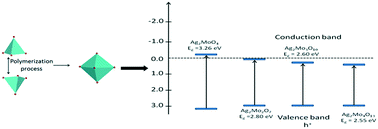A systematic study on polymerization and photocatalytic performance by investigating Ag2O·x(MoO3) (x = 1, 2, 3, 4) photocatalysts
Abstract
In this study, the relationship of polymerization and photocatalytic performance was systematically studied by investigating a series of Ag2O·x(MoO3) (x = 1, 2, 3, 4) samples. Characterization results indicated that two decisive factors of photocatalytic performance, light harvesting and the separation of charge carriers, were significantly influenced by polymerization. UV-vis diffuse reflectance spectra (DRS) illustrated that the visible light absorption range was significantly increased with the increase of polymerization degree. Photocurrent measurement showed that the separation of charge carriers increased until the polymerization degree increased to three, and further increase of polymerization degree restrained the separation of charge carriers because of the narrow band gap. The degradation experiment showed that the photocatalytic performance was significantly enhanced by polymerization, and the degradation rates of Ag2Mo3O10 and Ag2Mo4O13 reached a maximum and were nearly the same. Density functional theory (DFT) calculation was applied to explain the enhancement mechanism of light harvesting and photocurrent properties. This study strongly suggests that polymerization must be taken into account for design and exploitation of efficient photocatalysts.



 Please wait while we load your content...
Please wait while we load your content...